Is the Indus Basin Drying? Disparities in the Environmental Flow, Inflow, and Outflow of the Basin
Abstract
1. Introduction
2. Materials and Methods
2.1. Study Area and Dataset
2.2. Methods
2.2.1. Seasonal Flow Duration Curve
Flood Seasons
Cropping Seasons
2.2.2. Calculations of Environmental Flow Components
2.2.3. Wavelet Analysis
3. Results
3.1. Availability and Variations of Flows in Flood Seasons
3.1.1. Pre-Flood Season
3.1.2. Flood Season
3.1.3. Post-Flood Season
3.2. Periodical Changes in Low and High Flows
3.2.1. Pre-Flood Season
3.2.2. Flood Season
3.2.3. Post-Flood Season
3.3. Discrepancies of Flows in Cropping Seasons
3.4. Periodical Changes of Flows in Flood Seasons
3.4.1. Rabi Season
3.4.2. Kharif Season
3.5. Environmental Flow Components
3.5.1. Variations in Extremely Low Flows and High-Flow Pulses
3.5.2. Periodical Changes in the Low Flows and High Pulses
3.5.3. Magnitude in the Small and High Floods
3.5.4. Periodical Changes in the Small and High Floods
3.6. Discrepancies in the EFC Inflow and Outflow of the Indus Basin
3.7. Drying of the Indus Basin Due to Declining and Variable Inflows and Outflows from the Indus Basin
4. Discussion
4.1. Low and High Flows
4.2. Climate Change Linkages with the Waters of the Indus Basin
4.3. Environmental Flows
4.4. Indus Water Treaty and Environmental Flows
4.5. Limitations of This Study
5. Conclusions
Supplementary Materials
Author Contributions
Funding
Data Availability Statement
Acknowledgments
Conflicts of Interest
References
- Guo, W.; Yang, H.; Ma, Y.; Hong, F.; Wang, H. Comprehensive evaluation of the hydrological health evolution and its driving forces in the river-lake system. Ecol. Inform. 2023, 75, 102117. [Google Scholar] [CrossRef]
- Wen, C.; Zhen, Z.; Zhang, L.; Yan, C. A bibliometric analysis of river health based on publications in the last three decades. Environ. Sci. Pollut. Res. 2023, 30, 15400–15413. [Google Scholar] [CrossRef] [PubMed]
- Shan, C.; Dong, Z.; Lu, D.; Xu, C.; Wang, H.; Ling, Z.; Liu, Q. Study on river health assessment based on a fuzzy matter-element extension model. Ecol. Indic. 2021, 127, 107742. [Google Scholar] [CrossRef]
- Jiao, H.; Guo, W.; Jiao, X. Evaluation of hydrological regime alteration and ecological effects in the upper reaches of the Yangtze River, China. Water Supply 2023, 23, 1827–1842. [Google Scholar] [CrossRef]
- Cheng, X.; Chen, L.; Sun, R.; Kong, P. Land use changes and socio-economic development strongly deteriorate river ecosystem health in one of the largest basins in China. Sci. Total Environ. 2018, 616, 376–385. [Google Scholar] [CrossRef] [PubMed]
- Zhao, C.; Yang, Y.; Yang, S.; Xiang, H.; Zhang, Y.; Wang, Z.; Chen, X.; Mitrovic, S. Predicting future river health in a minimally influenced mountainous area under climate change. Sci. Total Environ. 2019, 656, 1373–1385. [Google Scholar] [CrossRef]
- Castellanos-Osorio, G.; Lopez-Ballesteros, A.; Perez-Sanchez, J.; Senent-Aparicio, J. Disaggregated monthly SWAT plus model versus daily SWAT plus model for estimating environmental flows in Peninsular Spain. J. Hydrol. 2023, 623, 129837. [Google Scholar] [CrossRef]
- de Sousa, L.F.; Ferraz, L.L.; Santos, C.A.S.; Rocha, F.A.; de Jesus, R.M. Assessment of hydrological trends and changes in hydroclimatic and land use parameters in a river basin in northeast Brazil. J. South Am. Earth Sci. 2023, 128, 104464. [Google Scholar] [CrossRef]
- El Jeitany, J.; Pacetti, T.; Caporali, E. Evaluating climate change effects on hydrological functionality and water-related ecosystem services. Ecohydrology 2023, 17, e2557. [Google Scholar] [CrossRef]
- Peng, F.; Shi, X.; Li, K.; Wang, Y.; Feng, J.; Li, R.; Liang, R. How to comprehensively evaluate river discharge under the influence of a dam. Ecol. Inform. 2022, 69, 101637. [Google Scholar] [CrossRef]
- Ramesh, V.V.S.; Thampi, S.G. Application of hydrologic and hydraulic methods to calculate the environmental flow requirements of the Chaliyar river. Environ. Earth Sci. 2023, 82, 166. [Google Scholar] [CrossRef]
- Reyes-Cedeno, I.G.; Hernandez-Marin, M.; Pacheco-Guerrero, A.I.; Gannon, J.P. Comprehensive Methodology and Analysis to Determine the Environmental Flow Regime in the Temporary Stream “La Yerbabuena” in Aguascalientes, Mexico. Water 2023, 15, 879. [Google Scholar] [CrossRef]
- Wang, H.X.; Cheng, S.Y.; He, N.; Huang, L.T.; Yang, H.; Hong, F.T.; Ma, Y.C.; Chen, W.X.; Guo, W.X. Multi-scale flow regimes and driving forces analysis based on different models: A case study of the Wu river basin. Water Supply 2023, 23, 3978–3996. [Google Scholar] [CrossRef]
- Gates, K.K.; Vaughn, C.C.; Julian, J.P. Developing environmental flow recommendations for freshwater mussels using the biological traits of species guilds. Freshw. Biol. 2015, 60, 620–635. [Google Scholar] [CrossRef]
- Akter, A.; Tanim, A. A modeling approach to establish environmental flow threshold in ungauged semidiurnal tidal river. J. Hydrol. 2018, 558, 442–459. [Google Scholar] [CrossRef]
- Horne, A.C.; Nathan, R.; Poff, N.L.; Bond, N.R.; Webb, J.A.; Wang, J.; John, A. Modeling flow-ecology responses in the anthropocene: Challenges for sustainable riverine management. BioScience 2019, 69, 789–799. [Google Scholar] [CrossRef]
- Su, Y.; Li, W.; Liu, L.; Hu, W.; Li, J.; Sun, X.; Li, Y. Health assessment of small-to-medium sized rivers: Comparison between comprehensive indicator method and biological monitoring method. Ecol. Indic. 2021, 126, 107686. [Google Scholar] [CrossRef]
- Zhang, Z.; Li, Y.; Wang, X.; Li, H.; Zheng, F.; Liao, Y.; Tang, N.; Chen, G.; Yang, C. Assessment of river health based on a novel multidimensional similarity cloud model in the Lhasa River, Qinghai-Tibet Plateau. J. Hydrol. 2021, 603, 127100. [Google Scholar] [CrossRef]
- Chen, H.; Li, W.; Zuo, Q.; Zhang, Y.; Liang, S. Evaluation of aquatic ecological health of sluice-controlled rivers in Huai River Basin (China) using evaluation index system. Environ. Sci. Pollut. Res. 2022, 29, 65128–65143. [Google Scholar] [CrossRef]
- Tsai, W.-P.; Chang, F.-J.; Chang, L.-C.; Herricks, E.E. AI techniques for optimizing multi-objective reservoir operation upon human and riverine ecosystem demands. J. Hydrol. 2015, 530, 634–644. [Google Scholar] [CrossRef]
- Ezzeldin, R.; Abd-Elmaboud, M. Modeling flow resistance and geometry of dunes bed form in alluvial channels using hybrid RANN–AHA and GEP models. Int. J. Sediment Res. 2024, 39, 885–902. [Google Scholar] [CrossRef]
- Fang, G.; Yan, M.; Dai, L.; Huang, X.; Zhang, X.; Lu, Y. Improved indicators of hydrological alteration for quantifying the dam-induced impacts on flow regimes in small and medium-sized rivers. Sci. Total Environ. 2023, 867, 161499. [Google Scholar] [CrossRef]
- Black, A.; Rowan, J.; Duck, R.; Bragg, O.; Clelland, B. DHRAM: A method for classifying river flow regime alterations for the EC Water Framework Directive. Aquat. Conserv. Mar. Freshw. Ecosyst. 2005, 15, 427–446. [Google Scholar] [CrossRef]
- Bello, C.; Suarez, W.; Drenkhan, F.; Vega-Jácome, F. Hydrological impacts of dam regulation for hydropower production: The case of Lake Sibinacocha, Southern Peru. J. Hydrol. Reg. Stud. 2023, 46, 101319. [Google Scholar] [CrossRef]
- Nilsson, C.; Reidy, C.A.; Dynesius, M.; Revenga, C. Fragmentation and flow regulation of the world’s large river systems. Science 2005, 308, 405–408. [Google Scholar] [CrossRef] [PubMed]
- Lehner, B.; Liermann, C.R.; Revenga, C.; Vörösmarty, C.; Fekete, B.; Crouzet, P.; Döll, P.; Endejan, M.; Frenken, K.; Magome, J. High-resolution mapping of the world’s reservoirs and dams for sustainable river-flow management. Front. Ecol. Environ. 2011, 9, 494–502. [Google Scholar] [CrossRef]
- Timpe, K.; Kaplan, D. The changing hydrology of a dammed Amazon. Sci. Adv. 2017, 3, e1700611. [Google Scholar] [CrossRef]
- Cui, T.; Tian, F.; Yang, T.; Wen, J.; Khan, M.Y.A. Development of a comprehensive framework for assessing the impacts of climate change and dam construction on flow regimes. J. Hydrol. 2020, 590, 125358. [Google Scholar] [CrossRef]
- Mezger, G.; del Tánago, M.G.; De Stefano, L. Environmental flows and the mitigation of hydrological alteration downstream from dams: The Spanish case. J. Hydrol. 2021, 598, 125732. [Google Scholar] [CrossRef]
- Gao, Y.; Vogel, R.M.; Kroll, C.N.; Poff, N.L.; Olden, J.D. Development of representative indicators of hydrologic alteration. J. Hydrol. 2009, 374, 136–147. [Google Scholar] [CrossRef]
- Mims, M.C.; Olden, J.D. Fish assemblages respond to altered flow regimes via ecological filtering of life history strategies. Freshw. Biol. 2013, 58, 50–62. [Google Scholar] [CrossRef]
- Bunn, S.E.; Arthington, A.H. Basic Principles and Ecological Consequences of Altered Flow Regimes for Aquatic Biodiversity. Environ. Manag. 2002, 30, 492–507. [Google Scholar] [CrossRef] [PubMed]
- Arthington, A.H.; Naiman, R.J.; McClain, M.E.; Nilsson, C. Preserving the biodiversity and ecological services of rivers: New challenges and research opportunities. Freshw. Biol. 2010, 55, 1–16. [Google Scholar] [CrossRef]
- Wang, W.; Zhang, Y.; Geng, X.; Tang, Q. Impact Classification of Future Land Use and Climate Changes on Flow Regimes in the Yellow River Source Region, China. J. Geophys. Res. Atmos. 2021, 126, e2020JD034064. [Google Scholar] [CrossRef]
- UN-Water. Water and Climate Change. The United Nations World Water Development Report 2020; UN-Water: Geneva, Switzerland, 2020. [Google Scholar]
- Lucinda, J. The United Nations World Water Development Report 2015: Water for a Sustainable World; UN-Water: Geneva, Switzerland, 2016; pp. 64–65. [Google Scholar]
- Hafeez, M.; Awan, U.K. Water Resource Potential: Status and Overview. In Water Policy in Pakistan: Issues and Options; Ahmad, M., Ed.; Springer International Publishing: Cham, Switzerland, 2023; pp. 73–90. [Google Scholar]
- Janjua, S.; Hassan, I.; Muhammad, S.; Ahmed, S.; Ahmed, A. Water management in Pakistan’s Indus Basin: Challenges and opportunities. Water Policy 2021, 23, 1329–1343. [Google Scholar] [CrossRef]
- Archer, D.R.; Forsythe, N.; Fowler, H.J.; Shah, S.M. Sustainability of water resources management in the Indus Basin under changing climatic and socio economic conditions. Hydrol. Earth Syst. Sci. 2010, 14, 1669–1680. [Google Scholar] [CrossRef]
- Luo, T.; Young, R.; Reig, P. Aqueduct Projected Water Stress Country Rankings; World Resources Institute: Washington, DC, USA, 2015. [Google Scholar]
- SBP. State Bank of Pakistan’s Annual Report 2016–17; State Bank of Pakistan: Karachi, Pakistan, 2017. [Google Scholar]
- Ahmed, N.; Wang, G.; Booij, M.J.; Ceribasi, G.; Bhat, M.S.; Ceyhunlu, A.I.; Ahmed, A. Changes in monthly streamflow in the Hindukush–Karakoram–Himalaya Region of Pakistan using innovative polygon trend analysis. Stoch. Environ. Res. Risk Assess. 2021, 36, 811–830. [Google Scholar] [CrossRef]
- Bandaragoda, D.J.; ur Rehman, S. Warabandi in Pakistan’s Canal Irrigation Systems: Widening Gap Between Theory and Practice; IWMI: Colombo, Sri Lanka, 1995. [Google Scholar]
- Ringler, C.; Anwar, A. Water for food security: Challenges for Pakistan. Water Int. 2013, 38, 505–514. [Google Scholar] [CrossRef]
- Reinsch, M.; Pearce, D. Pakistan: Country Water Resources Assistance Strategy, Water Economy: Running Dry; 0821337793; World Bank: Washington, DC, USA, 2005. [Google Scholar]
- Ahmad, S.; Ahmad, G. Water Supply and Demand: National and Regional Trends. In Water Policy in Pakistan: Issues and Options; Ahmad, M., Ed.; Springer International Publishing: Cham, Switzerland, 2023; pp. 91–121. [Google Scholar]
- Dars, G.H.; Lashari, B.K.; Soomro, M.S.; Strong, C.; Ansari, K. Pakistan’s Water Resources in the Era of Climate Change. In Water Resources of Pakistan: Issues and Impacts; Watto, M.A., Mitchell, M., Bashir, S., Eds.; Springer International Publishing: Cham, Switzerland, 2021; pp. 95–108. [Google Scholar]
- Yang, Y.-C.E.; Brown, C.; Yu, W.; Wescoat, J.; Ringler, C. Water governance and adaptation to climate change in the Indus River Basin. J. Hydrol. 2014, 519, 2527–2537. [Google Scholar] [CrossRef]
- Ur Rahman, K.; Shang, S.; Balkhair, K.; Nusrat, A. Catchment-Scale Drought Propagation Assessment in the Indus Basin of Pakistan Using a Combined Approach of Principal Components and Wavelet Analyses. J. Hydrometeorol. 2023, 24, 601–624. [Google Scholar] [CrossRef]
- FAO. AQUASTAT Transboundary River Basins—Indus River Basin; Food and Agriculture Organization of the United Nations (FAO): Rome, Italy, 2011. [Google Scholar]
- Immerzeel, W.W.; Van Beek, L.P.; Bierkens, M.F. Climate change will affect the Asian water towers. Science 2010, 328, 1382–1385. [Google Scholar] [CrossRef] [PubMed]
- Dars, G.H.; Najafi, M.R.; Qureshi, A.L. Assessing the impacts of climate change on future precipitation trends based on downscaled CMIP5 simulations data. Mehran Univ. Res. J. Eng. Technol. 2017, 36, 385–394. [Google Scholar] [CrossRef]
- Adams, T.E. Chapter 12—Water Resources Forecasting Within the Indus River Basin: A Call for Comprehensive Modeling. In Indus River Basin; Khan, S.I., Adams, T.E., Eds.; Elsevier: Amsterdam, The Netherlands, 2019; pp. 267–308. [Google Scholar]
- Eckstein, D.; Künzel, V.; Schäfer, L. Risk Index 2018. Who Suffers Most from Extreme Weather Events? Weather-Related Loss Events in 2016 and 1997 to 2016; Germanwatch: Bonn, Germany, 2017. [Google Scholar]
- Khan, A.; Idrees, M.H. The Impact of Climate Change on the Indus Basin: Challenges and Constraints. In Water Policy in Pakistan: Issues and Options; Ahmad, M., Ed.; Springer International Publishing: Cham, Switzerland, 2023; pp. 225–248. [Google Scholar]
- United Nations. The Indus Waters Treaty 1960 between the Government of India, the Government of Pakistan and the International Bank for Reconstruction and Development; United Nations: New York, NY, USA, 1960; Volume 19, pp. 300–365. [Google Scholar]
- Nabeel, F.; Cheema, M.J.M. Pakistan’s Transboundary Water Challenge. In Water Resources of Pakistan: Issues and Impacts; Watto, M.A., Mitchell, M., Bashir, S., Eds.; Springer International Publishing: Cham, Switzerland, 2021; pp. 37–55. [Google Scholar]
- Anwar, A.A.; Bhatti, M.T. Pakistan’s Water Apportionment Accord of 1991: 25 Years and Beyond. J. Water Resour. Plan. Manag. 2018, 144, 05017015. [Google Scholar] [CrossRef]
- Ahmed, N.; Lü, H.; Ahmed, S.; Adeyeri, O.E.; Ali, S.; Hussain, R.; Shah, S. Transboundary River Water Availability to Ravi Riverfront under Changing Climate: A Step towards Sustainable Development. Sustainability 2023, 15, 3526. [Google Scholar] [CrossRef]
- Searcy, J.K. Flow-Duration Curves; US Government Printing Office: Washington, DC, USA, 1959.
- Chouaib, W.; Caissie, D. Regional disparities in water availability and low flow conditions in rivers across Canada. J. Hydrol. 2021, 598, 126195. [Google Scholar] [CrossRef]
- Wang, Z.; Sun, S.; Song, C.; Wang, G.; Lin, S.; Ye, S. Variation characteristics of high flows and their responses to climate change in permafrost regions on the Qinghai-Tibet Plateau, China. J. Clean. Prod. 2022, 376, 134369. [Google Scholar] [CrossRef]
- Davies, S.; Young, W. Unlocking Economic Growth Under a Changing Climate: Agricultural Water Reforms in Pakistan. In Water Resources of Pakistan: Issues and Impacts; Watto, M.A., Mitchell, M., Bashir, S., Eds.; Springer International Publishing: Cham, Switzerland, 2021; pp. 109–131. [Google Scholar]
- Yang, Y.C.E.; Ringler, C.; Brown, C.; Mondal, M.A.H. Modeling the Agricultural Water–Energy–Food Nexus in the Indus River Basin, Pakistan. J. Water Resour. Plan. Manag. 2016, 142, 04016062. [Google Scholar] [CrossRef]
- Richter, B.; Baumgartner, J.; Wigington, R.; Braun, D. How much water does a river need? Freshw. Biol. 1997, 37, 231–249. [Google Scholar] [CrossRef]
- Guan, X.; Zhang, Y.; Meng, Y.; Liu, Y.; Yan, D. Study on the theories and methods of ecological flow guarantee rate index under different time scales. Sci. Total Environ. 2021, 771, 145378. [Google Scholar] [CrossRef]
- Fair, C.C.; Kuhn, P.; Malhotra, N.A.; Shapiro, J. Natural disasters and political engagement: Evidence from the 2010–11 Pakistani floods. Q. J. Political Sci. 2017, 12, 99–141. [Google Scholar] [CrossRef]
- Meadows, A.; Meadows, P.S. The Indus River: Biodiversity, Resources, Humankind; Oxford University Press: Karachi, Pakistan, 1999. [Google Scholar]
- Adeyeri, O.E.; Laux, P.; Arnault, J.; Lawin, A.E.; Kunstmann, H. Conceptual hydrological model calibration using multi-objective optimization techniques over the transboundary Komadugu-Yobe basin, Lake Chad Area, West Africa. J. Hydrol. Reg. Stud. 2020, 27, 100655. [Google Scholar] [CrossRef]
- Ahmed, N.; Wang, G.; Booij, M.J.; Oluwafemi, A.; Hashmi, M.Z.-u.-R.; Ali, S.; Munir, S. Climatic Variability and Periodicity for Upstream Sub-Basins of the Yangtze River, China. Water 2020, 12, 842. [Google Scholar] [CrossRef]
- Adeyeri, O.E.; Ishola, K.A. Variability and Trends of Actual Evapotranspiration over West Africa: The Role of Environmental Drivers. Agric. For. Meteorol. 2021, 308–309, 108574. [Google Scholar] [CrossRef]
- Yerdelen, C.; Abdelkader, M.; Eris, E. Assessment of drought in SPI series using continuous wavelet analysis for Gediz Basin, Turkey. Atmos. Res. 2021, 260, 105687. [Google Scholar] [CrossRef]
- Ndehedehe, C.E.; Adeyeri, O.E.; Onojeghuo, A.O.; Ferreira, V.G.; Kalu, I.; Okwuashi, O. Understanding global groundwater-climate interactions. Sci. Total Environ. 2023, 904, 166571. [Google Scholar] [CrossRef]
- Adeyeri, O.E.; Zhou, W.; Ndehedehe, C.E.; Wang, X. Global vegetation, moisture, thermal and climate interactions intensify compound extreme events. Sci. Total Environ. 2024, 912, 169261. [Google Scholar] [CrossRef]
- Watto, M.A.; Mitchell, M.; Akhtar, T. Pakistan’s Water Resources: Overview and Challenges. In Water Resources of Pakistan: Issues and Impacts; Watto, M.A., Mitchell, M., Bashir, S., Eds.; Springer International Publishing: Cham, Switzerland, 2021; pp. 1–12. [Google Scholar]
- Kamal, S. Pakistan’s Water: Changing the Narrative, Changing the Outcomes. In Water Policy in Pakistan: Issues and Options; Ahmad, M., Ed.; Springer International Publishing: Cham, Switzerland, 2023; pp. 5–31. [Google Scholar]
- Abbas, Y.; Khan, N.M.; Mughal, H.-U.-R.; Mahmood, K. Assessing inflow variability at rim stations of the Indus Basin Irrigation System*. Irrig. Drain. 2020, 69, 997–1011. [Google Scholar] [CrossRef]
- Immerzeel, W.W.; Lutz, A.; Andrade, M.; Bahl, A.; Biemans, H.; Bolch, T.; Hyde, S.; Brumby, S.; Davies, B.; Elmore, A. Importance and vulnerability of the world’s water towers. Nature 2020, 577, 364–369. [Google Scholar] [CrossRef]
- Sattar, E.; Azeem Shah, S. Pakistan’s Transboundary Water Governance Mechanisms and Challenges. In Water Policy in Pakistan: Issues and Options; Ahmad, M., Ed.; Springer International Publishing: Cham, Switzerland, 2023; pp. 369–397. [Google Scholar]
- Akhtar, T.; Khan, H.F.; Mustafa, D. Water Security in Pakistan: Availability, Accessibility and Utilisation. In Water Resources of Pakistan: Issues and Impacts; Watto, M.A., Mitchell, M., Bashir, S., Eds.; Springer International Publishing: Cham, Switzerland, 2021; pp. 57–78. [Google Scholar]
- Young, W.J.; Anwar, A.; Bhatti, T.; Borgomeo, E.; Davies, S.; Garthwaite, W.R., III; Gilmont, E.M.; Leb, C.; Lytton, L.; Makin, I. Pakistan: Getting More from Water; World Bank: Washington, DC, USA, 2019. [Google Scholar]
- Cheema, M.J.M.; Qamar, M.U. Chapter 8—Transboundary Indus River Basin: Potential Threats to Its Integrity. In Indus River Basin; Khan, S.I., Adams, T.E., Eds.; Elsevier: Amsterdam, The Netherlands, 2019; pp. 183–201. [Google Scholar]
- Hasson, S.u.; Pascale, S.; Lucarini, V.; Böhner, J. Seasonal cycle of precipitation over major river basins in South and Southeast Asia: A review of the CMIP5 climate models data for present climate and future climate projections. Atmos. Res. 2016, 180, 42–63. [Google Scholar] [CrossRef]
- Gebre, S.; Ludwig, F. Spatial and temporal variation of impacts of climate change on the hydrometeorology of Indus River Basin using RCPs scenarios, South East Asia. J. Earth Sci. Clim. Change 2014, 5, 1–7. [Google Scholar]
- Su, B.; Huang, J.; Gemmer, M.; Jian, D.; Tao, H.; Jiang, T.; Zhao, C. Statistical downscaling of CMIP5 multi-model ensemble for projected changes of climate in the Indus River Basin. Atmos. Res. 2016, 178–179, 138–149. [Google Scholar] [CrossRef]
- Kazmi, D.H.; Li, J.; Rasul, G.; Tong, J.; Ali, G.; Cheema, S.B.; Liu, L.; Gemmer, M.; Fischer, T. Statistical downscaling and future scenario generation of temperatures for Pakistan Region. Theor. Appl. Climatol. 2015, 120, 341–350. [Google Scholar] [CrossRef]
- Rajbhandari, R.; Shrestha, A.B.; Kulkarni, A.; Patwardhan, S.K.; Bajracharya, S.R. Projected changes in climate over the Indus river basin using a high resolution regional climate model (PRECIS). Clim. Dyn. 2015, 44, 339–357. [Google Scholar] [CrossRef]
- Forsythe, N.; Fowler, H.J.; Blenkinsop, S.; Burton, A.; Kilsby, C.G.; Archer, D.R.; Harpham, C.; Hashmi, M.Z. Application of a stochastic weather generator to assess climate change impacts in a semi-arid climate: The Upper Indus Basin. J. Hydrol. 2014, 517, 1019–1034. [Google Scholar] [CrossRef]
- Chaudhry, Q.; Mahmood, A.; Rasul, G.; Afzaal, M. Climate Change Indicators of Pakistan; Technical Report No. PMD 22/2009; Pakistan Meteorological Department: Islamabad, Pakistan, 2009. [Google Scholar]
- Lutz, A.F.; ter Maat, H.W.; Biemans, H.; Shrestha, A.B.; Wester, P.; Immerzeel, W.W. Selecting representative climate models for climate change impact studies: An advanced envelope-based selection approach. Int. J. Climatol. 2016, 36, 3988–4005. [Google Scholar] [CrossRef]
- Kraaijenbrink, P.D.A.; Bierkens, M.F.P.; Lutz, A.F.; Immerzeel, W.W. Impact of a global temperature rise of 1.5 degrees Celsius on Asia’s glaciers. Nature 2017, 549, 257–260. [Google Scholar] [CrossRef]
- Ahmed, N.; Lu, H.; Booij, M.J.; Wang, G.; Marhaento, H.; Bhat, M.S.; Adnan, S. Innovative polygon trend analysis of monthly precipitation (1952–2015) in the Hindukush-Karakoram-Himalaya river basins of Pakistan. Int. J. Climatol. 2022, 42, 9967–9993. [Google Scholar] [CrossRef]
- Huang, J.; Wang, Y.; Fischer, T.; Su, B.; Li, X.; Jiang, T. Simulation and projection of climatic changes in the Indus River Basin, using the regional climate model COSMO-CLM. Int. J. Climatol. 2017, 37, 2545–2562. [Google Scholar] [CrossRef]
- Turner, A.G.; Annamalai, H. Climate change and the South Asian summer monsoon. Nat. Clim. Change 2012, 2, 587–595. [Google Scholar] [CrossRef]
- Ahmad, S.; Hussain, Z.; Qureshi, A.S.; Majeed, R.; Saleem, M. Drought Mitigation in Pakistan: Current Status and Options for Future Strategies; IWMI: Colombo, Sri Lanka, 2004; Volume 85. [Google Scholar]
- Houze, R.; Rasmussen, K.; Medina, S.; Brodzik, S.; Romatschke, U. Anomalous atmospheric events leading to the summer 2010 floods in Pakistan. Bull. Am. Meteorol. Soc. 2011, 92, 291–298. [Google Scholar] [CrossRef]
- Podger, G.M.; Ahmad, M.-u.-D.; Yu, Y.; Stewart, J.P.; Shah, S.M.M.A.; Khero, Z.I. Development of the Indus River System Model to Evaluate Reservoir Sedimentation Impacts on Water Security in Pakistan. Water 2021, 13, 895. [Google Scholar] [CrossRef]
- Subbarayan, S.; Youssef, Y.M.; Singh, L.; Dąbrowska, D.; Alarifi, N.; Ramsankaran, R.; Visweshwaran, R.; Saqr, A.M. Soil and Water Assessment Tool-Based Prediction of Runoff Under Scenarios of Land Use/Land Cover and Climate Change Across Indian Agro-Climatic Zones: Implications for Sustainable Development Goals. Water 2025, 17, 458. [Google Scholar] [CrossRef]

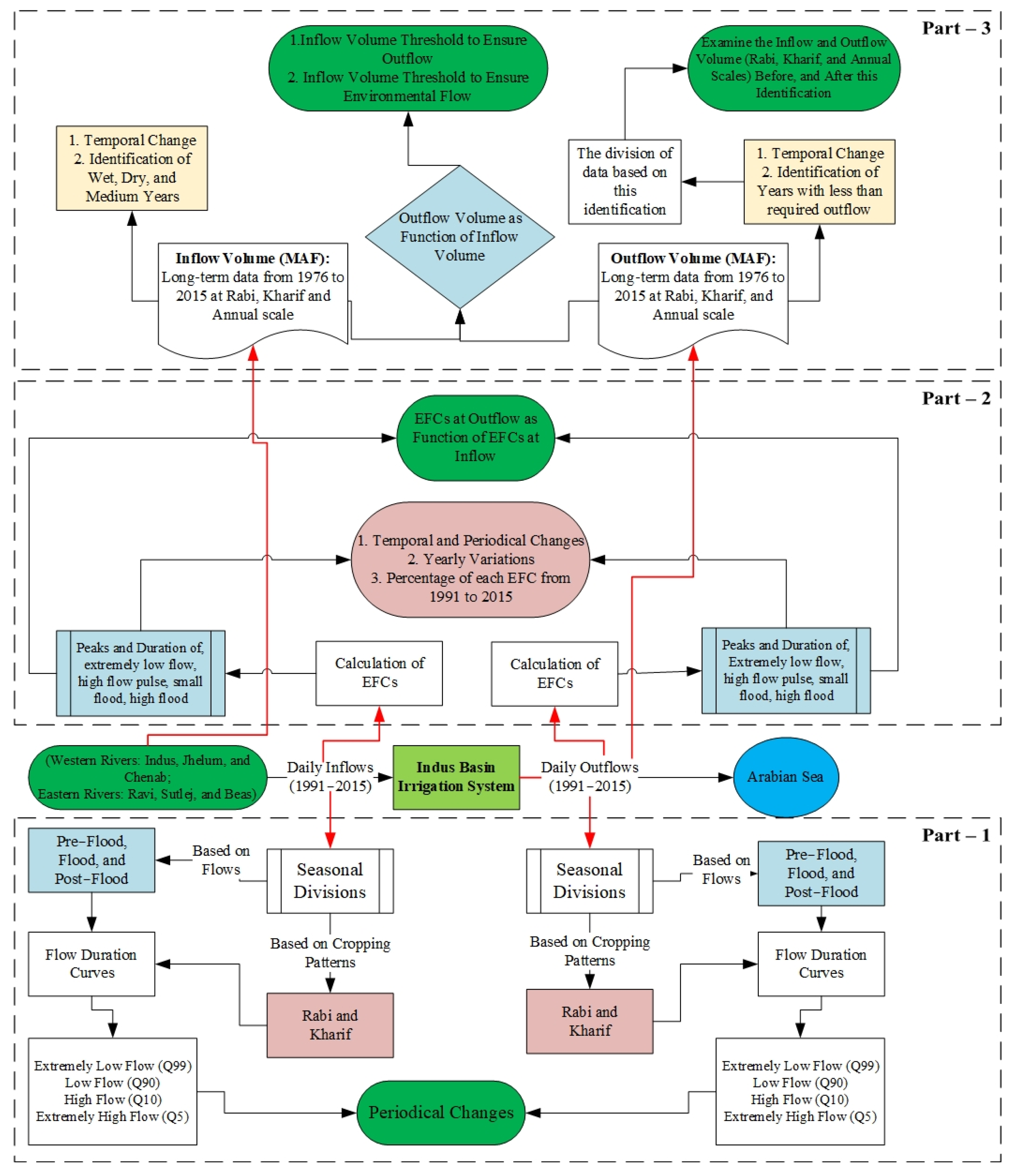
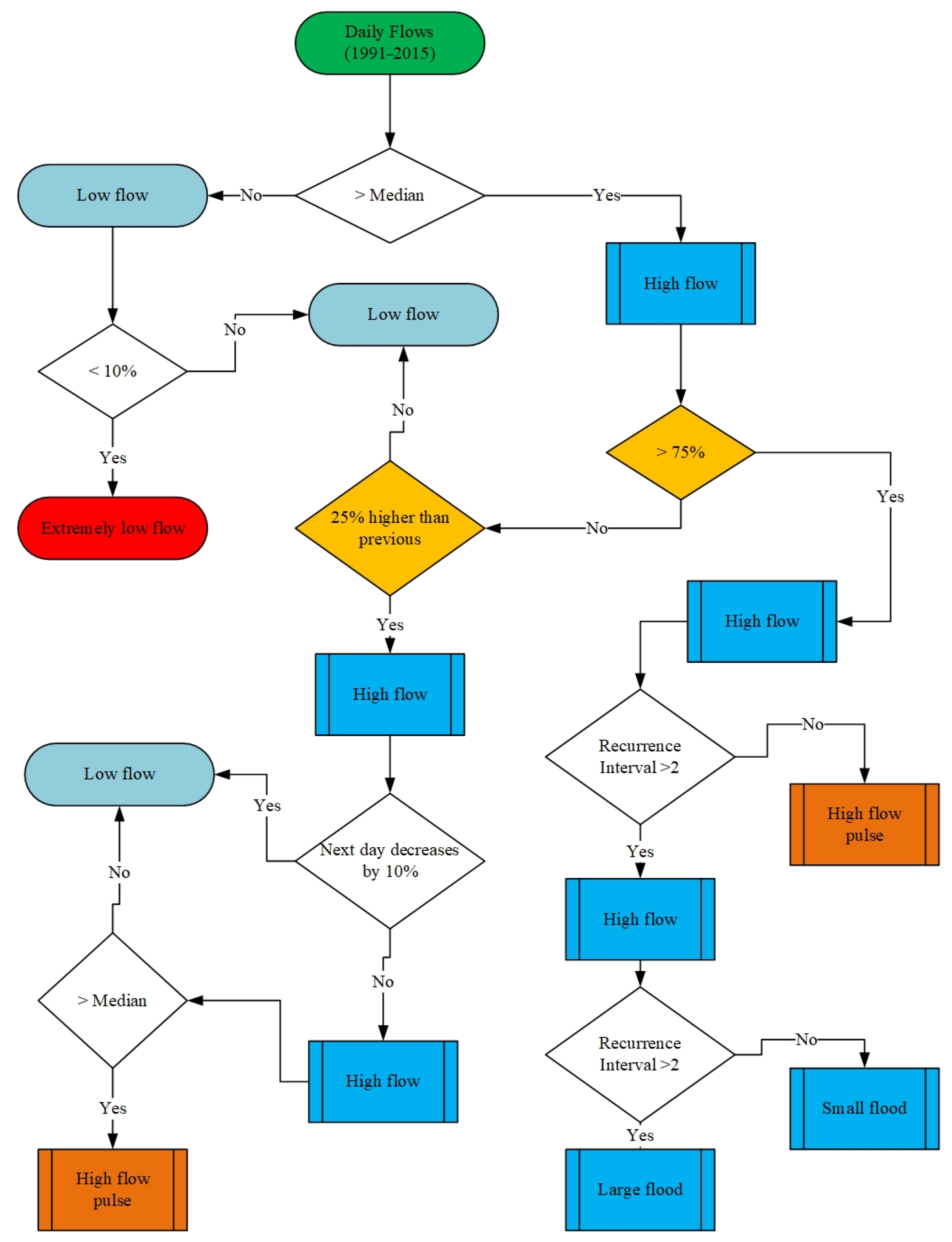
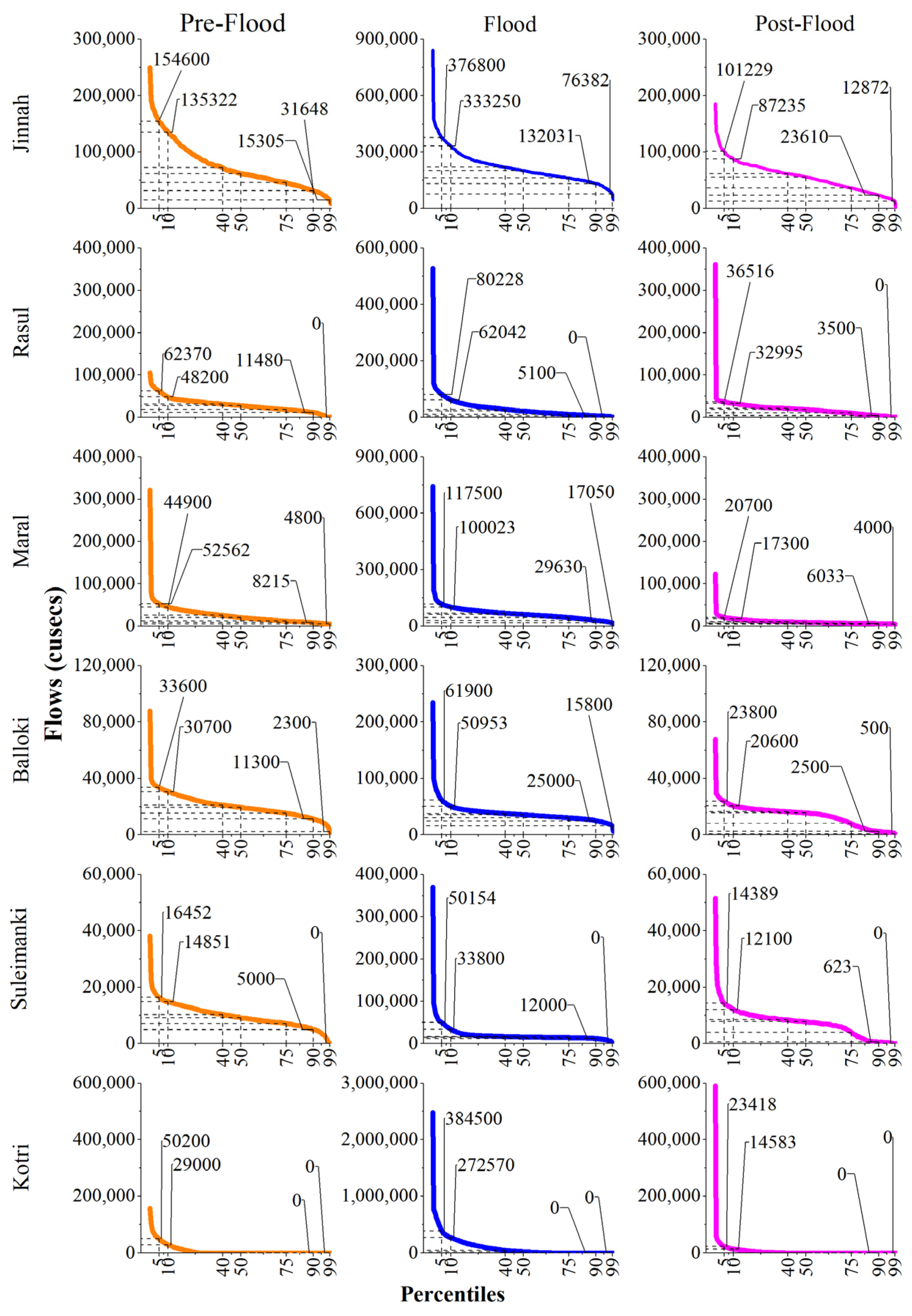

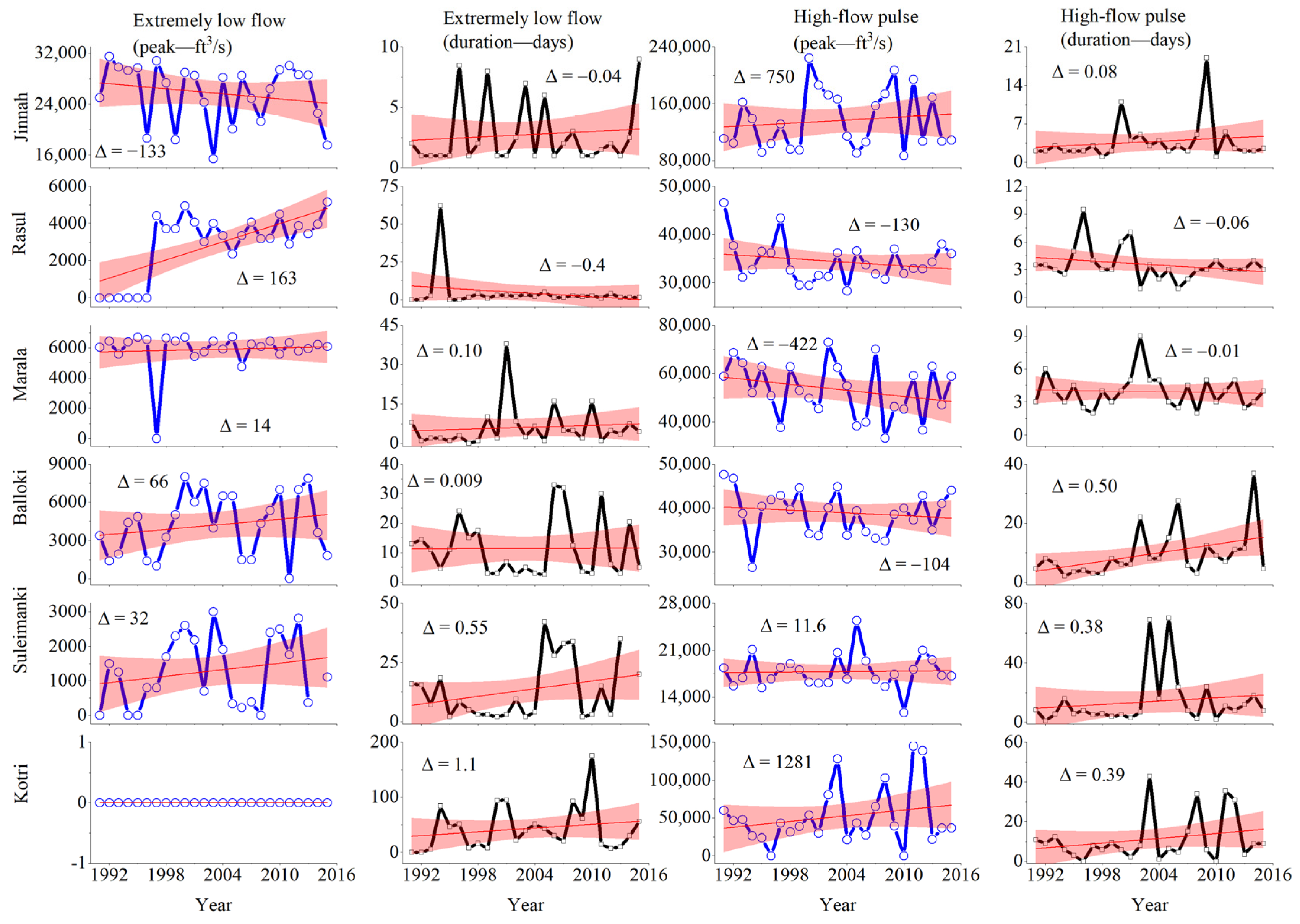
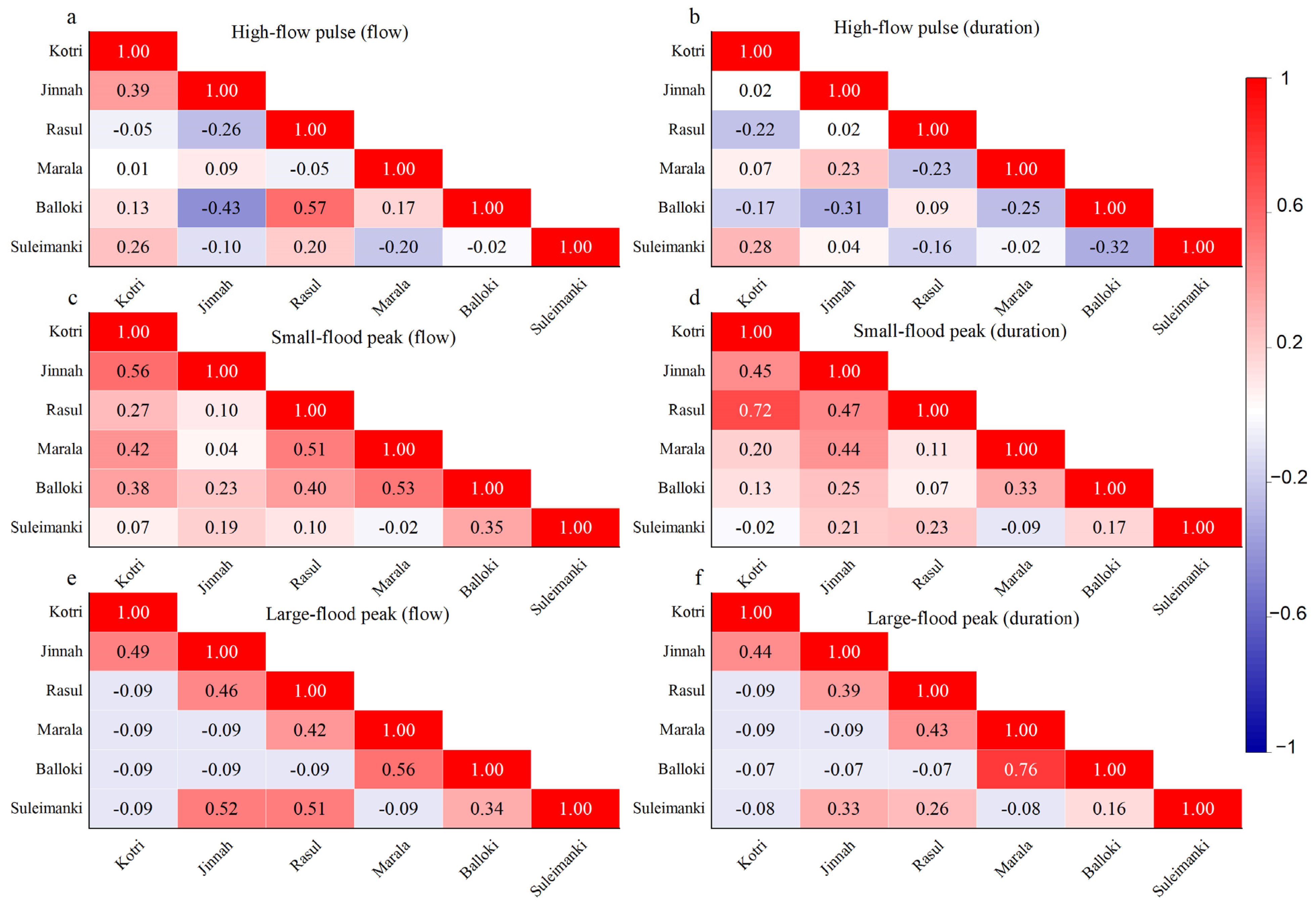
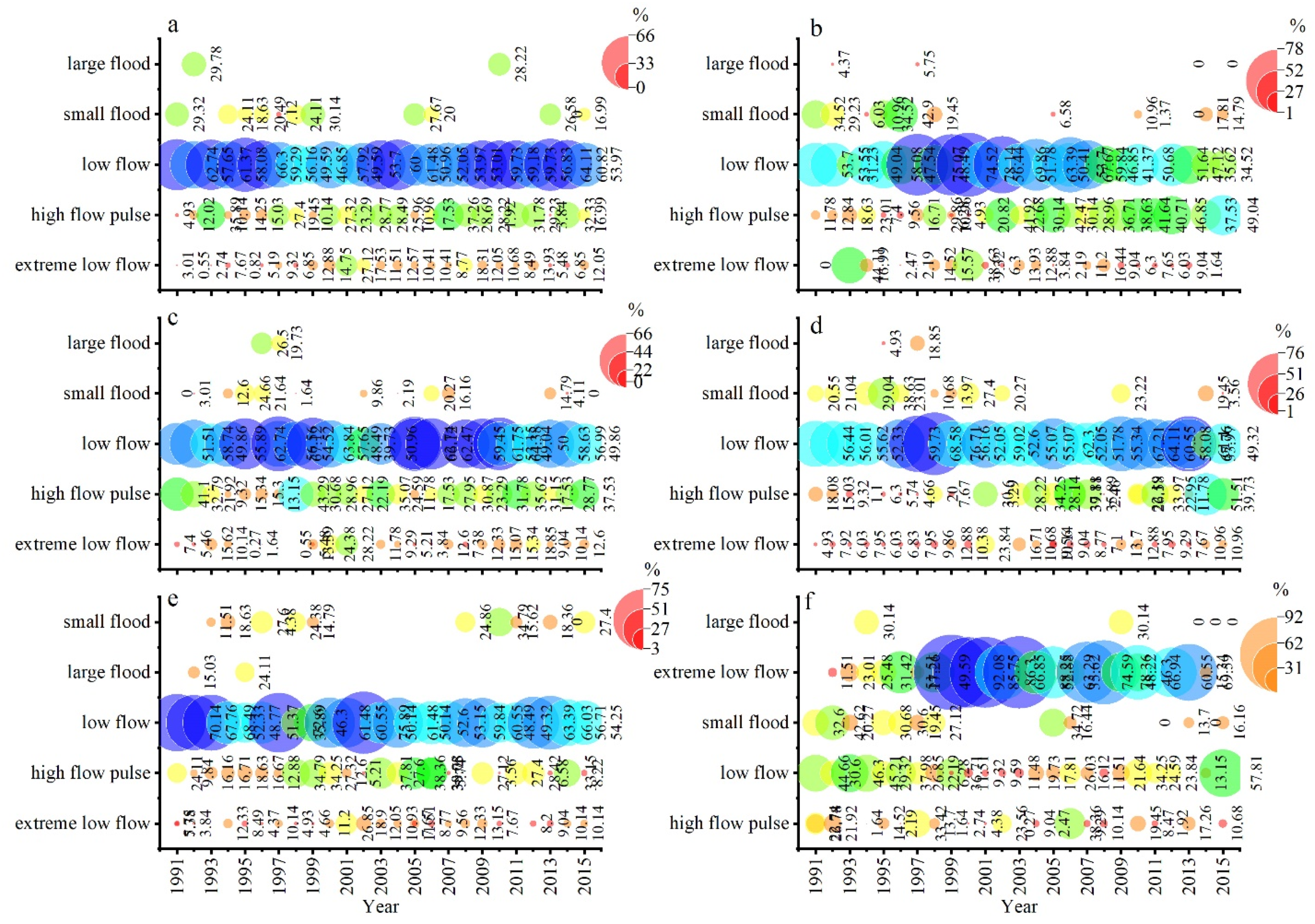

| Gauges | Type of EFC | Percentage |
|---|---|---|
| Jinnah | Low Flow | 57 |
| High-Flow Pulse | 20.87 | |
| Extreme Low Flow | 10 | |
| Small Flood | 9.8 | |
| Large Flood | 2.32 | |
| Rasul | Low Flow | 54.01 |
| High-Flow Pulse | 26.4 | |
| Extreme Low Flow | 10.01 | |
| Small Flood | 9.17 | |
| Large Flood | 0.41 | |
| Marala | Low Flow | 56.49 |
| High-Flow Pulse | 26.19 | |
| Extreme Low Flow | 10.24 | |
| Small Flood | 5.23 | |
| Large Flood | 1.85 | |
| Balloki | Low Flow | 57.56 |
| High-Flow Pulse | 21.45 | |
| Small Flood | 10.03 | |
| Extreme Low Flow | 10 | |
| Large Flood | 0.95 | |
| Suleimanki | Low Flow | 57.51 |
| High-Flow Pulse | 22.03 | |
| Extreme Low Flow | 10 | |
| Small Flood | 8.89 | |
| Large Flood | 1.57 | |
| Kotri | Extreme Low Flow | 49.63 |
| Low Flow | 25.38 | |
| High-Flow Pulse | 11.86 | |
| Small Flood | 10.72 | |
| Large Flood | 2.41 |
| Kharif (1976–2000) MAF | Rabi (1976–2000) MAF | Annual (1976–2000) MAF | Kharif (2000–2015) MAF | Rabi (2000–2015) MAF | Annual (2000–2015) MAF | Kharif (1976–2015) MAF | Rabi (1976–2015) MAF | Annual (1976–2015) MAF | |
|---|---|---|---|---|---|---|---|---|---|
| Western Rivers Inflow | 119.1 | 26.04 | 145.14 | 105.13 | 23.43 | 128.56 | 113.11 | 24.91 | 138.03 |
| Eastern Rivers Inflow | 7.14 | 1.93 | 9.07 | 2.15 | 0.65 | 2.8 | 4.99 | 1.38 | 6.38 |
| Total Inflow | 126.24 | 27.97 | 154.2 | 107.28 | 24.08 | 131.36 | 118.11 | 26.3 | 144.41 |
| Downstream Kotri | 36.92 | 2.48 | 39.4 | 13.45 | 0.65 | 14.1 | 26.85 | 1.69 | 28.55 |
| Required Downstream Kotri | 8.6 | 8.6 | 8.6 | 8.6 | 8.6 | 8.6 | 8.6 | 8.6 | 8.6 |
Disclaimer/Publisher’s Note: The statements, opinions and data contained in all publications are solely those of the individual author(s) and contributor(s) and not of MDPI and/or the editor(s). MDPI and/or the editor(s) disclaim responsibility for any injury to people or property resulting from any ideas, methods, instructions or products referred to in the content. |
© 2025 by the authors. Licensee MDPI, Basel, Switzerland. This article is an open access article distributed under the terms and conditions of the Creative Commons Attribution (CC BY) license (https://creativecommons.org/licenses/by/4.0/).
Share and Cite
Ahmed, N.; Lu, H.; Đurin, B.; Kranjčić, N.; Adeyeri, O.E.; Iqbal, M.S.; Youssef, Y.M. Is the Indus Basin Drying? Disparities in the Environmental Flow, Inflow, and Outflow of the Basin. Water 2025, 17, 1557. https://doi.org/10.3390/w17101557
Ahmed N, Lu H, Đurin B, Kranjčić N, Adeyeri OE, Iqbal MS, Youssef YM. Is the Indus Basin Drying? Disparities in the Environmental Flow, Inflow, and Outflow of the Basin. Water. 2025; 17(10):1557. https://doi.org/10.3390/w17101557
Chicago/Turabian StyleAhmed, Naveed, Haishen Lu, Bojan Đurin, Nikola Kranjčić, Oluwafemi E. Adeyeri, Muhammad Shahid Iqbal, and Youssef M. Youssef. 2025. "Is the Indus Basin Drying? Disparities in the Environmental Flow, Inflow, and Outflow of the Basin" Water 17, no. 10: 1557. https://doi.org/10.3390/w17101557
APA StyleAhmed, N., Lu, H., Đurin, B., Kranjčić, N., Adeyeri, O. E., Iqbal, M. S., & Youssef, Y. M. (2025). Is the Indus Basin Drying? Disparities in the Environmental Flow, Inflow, and Outflow of the Basin. Water, 17(10), 1557. https://doi.org/10.3390/w17101557










